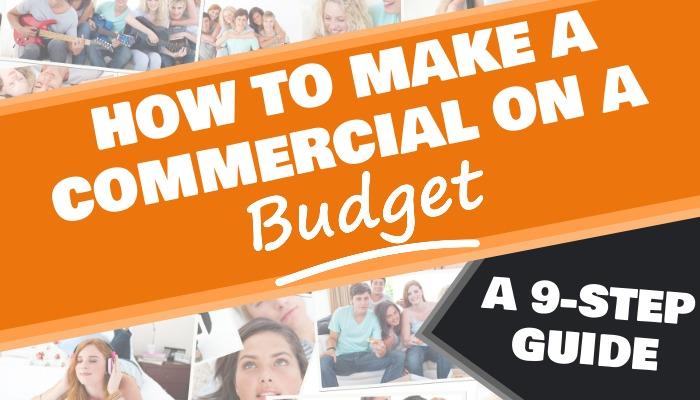Discover how to make a commercial on a budget in 9 cost-effective steps. Explore our guidance and find the type of commercial that best suits your business.
You don’t necessarily need a huge budget to create a high-quality video that promotes your products or services. If your funds are tight, a clever and simple idea can make you stand out as much as a clip with all the bells and whistles from a production company would.
As long as you’re willing to put in the work, you can design a commercial that is unique to your business and doesn’t put too much pressure on your finances. We’ve put together a step-by-step guide to help you on your journey towards a low-budget commercial production that impresses your target audience with its result.
Choose the Type of Commercial that Works for Your Business
Before you get started on planning your commercial, take a look at the types you can use to advertise your products or services. Which type you go for depends on your business, what you’re promoting, and your budget. Pick what fits best with these three factors and be creative to increase sales with your new commercial.
Convince Customers with a Straight Pitch

A straight pitch involves a person looking right into the camera and listing the benefits and features of what you’re promoting. The pitch also includes a call to action and how to get in touch with your business.
Bigger budget productions usually hire actors to do a professional pitch. On a smaller budget, it’s easier to get the business owner or a member of the sales team comfortable in front of a camera.
Focus on Your Product or Service with a Voice-Over Pitch
A voice-over pitch also tells your customers about the benefits and features of your products and services. In this type of commercial, the person moves in the background to put the focus on what’s being promoted. If you decide to go for a voice-over pitch commercial, make sure the narration and what’s shown on-screen always align to avoid confusing customers.
Build Trust with Testimonials

Testimonials can be a powerful way to create a more personal connection between customers and your brand. To integrate testimonials in a commercial, interview passionate customers, who are comfortable in front of a camera. Make sure their statements are authentic and don’t look staged to achieve your goal of building trust.
Get a diverse cast of customers to ensure your commercial is representative of the widest possible part of your target audience. This way, your customers can identify more easily with the people in your commercial helping to establish that vital connection you want to achieve.
Be Persuasive with Proof of Performance
If you’ve recently conducted some research into your business and have some impressive statistics to show off, a proof of performance commercial could be your way to engage your viewer. Weave your impressive numbers into your video and show how they support the solution to your customer’s pain points.
Deliver Proof with a Comparison

Another way to prove to prospective customers that your product or service is the right one for them is to compare what you’re promoting to your competitors.
Show your product or service as the winners and how they stand out to persuade your target audience to buy.
Hook Your Audience with the Story You Create
Stories have captivated humankind for thousands of years, a fact that led Joseph Campbell to write his famous work ‘The Hero with a Thousand Faces’. In it, he argues that all stories follow the pattern of the hero’s journey.
This structure can also be applied to advertising and used to create effective commercials that easily reel in a target audience. In its simplest form, it helps you to craft a narrative populated with characters who face a problem and use your product or service to solve it.
How to Make a Commercial on a Budget
Step 1: Plan for the Time and Budget You Have

To get started planning your commercial, think about your target audience, timing, and location. The demographics of your target audience determine the direction and tone of your content. You want to have a clear vision of what you’re aiming for in general.
Look at timing to either see if you want to invest in a seasonal event like Christmas with a potentially higher return or avoid that time of the year to save money. Commercial slots on radio and television can be more expensive during the holiday season. To save money, you might want to opt for the times in between big seasonal events to launch your commercial.
A big part of determining costs is also where you air your commercial. If you’re a small local business, contact your local radio and TV stations for more information instead of trying to get more expensive slots on national television.
Do some research and watch market trends. Arm yourself with all the information you can get for when it gets to the negotiation stage. When negotiating with a station, find out if their rates are flexible. For example, ask for extras like bonus spots or find out if they might show your commercial on their website.
This should give you an initial direction and a fixed cost for distribution to start putting together a budget plan. Other elements that you can add to get budgeting right are:
- Above the line expenses
- Below the line expenses
- Total fees
- Rates
- Variances
- Pre-production development
- Production staffing
- Budget for rights, music, and talent
- Crew and personnel expenses
- Travel expenses
- Post-Production expenses
- Insurance costs
- Office fees
Not all of these costs might apply to you and if you’re trying to produce your commercial on the lowest possible budget you want to keep what’s on your list to a minimum. Get your team to work on most stages if not all parts to avoid the additional costs of a production company. You can still add to your budget plan while writing your script.
Step 2: Develop a Script for Your Video
The script you craft for your commercial is still very much part of the planning phase and impacts your budget. It determines what’s needed to eventually shoot a short clip of promotional content. It’s a plan that you can build the rest of the steps on to get to your final footage.
Make sure you include the following in your script:
- The key message you want to get across.
- The location for your scenes.
- The actions happening in each shot.
- Other details like props and costumes needed to create each shot.
- The characters or actors on screen.
- The lines for the actors or voice-over narrator.
- The call to action and contact details of your business.
- Any stock videos you want to include to keep your budget low.
Be sure to be aware of what your competitors have been doing to create your original content and avoid going for the obvious. Jot down your key advertising message at the top of your script to make sure the entire team is clear on what the goal of your commercial is.
Brainstorm a new and interesting way to promote your product that represents your unique brand identity. Particularly when you’re working with a low budget, be careful to not go overboard and keep it simple.
Create an initial draft that you can refine over time as you learn about the opportunities open to you. Get input from your colleagues and share the final draft with your team to complete your script.
Step 3: Cast Your Commercial
To save money on casting, keep your script as simple as possible with a small cast or no on-screen actors at all. Decide whether you need one or more people to convey your key message or if your commercial might be suitable for a voice-over.
For both options make sure you’re clear on your character descriptions and have all your details nailed down for the casting process. The character in your commercial has to resonate with your target audience to establish a connection with your brand.
A tight budget might limit your casting call to go out to your team and friends or family. Look for the hidden talents among the people close to you. Your audition can be as simple as getting everyone together to read a few lines of your script for an afternoon.
Step 4: Keep Costumes and Props to a Minimum
If you keep the story in your script as simple as possible, there should be no need for elaborate costumes or hard to come by props. Reduce this need to the absolute minimum and ask if your actors are ok to wear their own clothes for the commercial.
If there’s a need for costumes, rent them for the day of the shoot. Try finding hidden treasures in the local thrift stores or charity shops. Ask your team if they have anything at home that could work or contact friends and family.
For example, a forgotten Halloween costume or a medieval outfit worn only once a year for the Renaissance festival might just be what you’re looking for. Ask as many people as possible and consider putting the call out on your private social channels to reach more people more quickly.
Get creative and don’t be afraid to try and make costumes and props yourself. YouTube is full of tutorials for anything you can imagine and beyond. Do some research and find the best way to craft what you need.
Step 5: Go on a Hunt for a Simple Location
When writing your script, make sure the setting in your commercial doesn’t change in every other shot. Go for generic locations like an office, a park, or a living room, which aren’t hard to find. Your set should be close by to reduce travel costs.
If you’re out location scouting, take as many photos from different angles as you can. Check whether you can rent a place or need to pay for permits or lockdowns. Keep health and safety as well as the logistics of fitting your team into a location in mind.
To find out if a potential setting is suitable for filming and plugging in equipment, look for electrical outlets and test them. Check the quality of sound with your smartphone and listen for any background noise like traffic or planes in the area.
Always be respectful of your chosen locations and their owners. Document how the area looked before you filmed your commercial and ensure it looks the same when you leave.
Depending on your budget, look for a location that you can get for a small fee or is free of charge. Remember that you can still adjust your script at this point in time to fit with the setting you can afford.
Step 6: Rent Equipment and Shoot Your Commercial
The amount of camera and lighting gear you need depends on the story in your script, the location, and the number of people that are going to be on-screen. Rent your equipment and make sure you understand how it works before the day of the shoot.
If possible, get the equipment the day before and get some test footage. This also includes a camera and lighting check to see if there are any issues that need to be fixed before the big day. Check the paperwork to ensure you received everything you ordered.
On the day of the shoot give yourself enough time to get everything set up at the location if you haven’t already done so the previous day to test the equipment. Recruit multiple members of your team to unload and set up the gear safely.
Your shooting day should be planned out alongside your script. Working according to a strict schedule will help keep filming to one or two days and to bring the rented equipment back on time. Everyone in the cast and crew should be ready to go. Prep work like rehearsals before shooting day is essential.
Get footage of your product and actors from different angles to be able to choose the best shot when you’re editing. Embrace your budget limitations and rely on your creativity to think of ways to make shots more dynamic and get different camera movements that make your commercial look more interesting.
Step 7: Edit Your Footage
If your budget doesn’t allow for buying the most up-to-date video editing software, consider open source options. If you’re also looking into including high-quality stock footage, online video editing tools like our Design Wizard Online Video Editor provide a vast library of stock videos.
When editing your commercial, start by selecting the best angles or camera movements that you want to include. Set the scene quickly and add your branding as early as possible. This doesn’t necessarily have to be your logo popping up in the first frame. It can also be a certain aesthetic or other recognizable feature that is unique to your business.
Ensure continuity between shots and emphasize your key message through your edits. Again, take the budget constraints you had to work with in stride and use your creativity to edit your commercial in the best possible way.
Edit with different formats in mind. Even if your commercial is initially aimed at being aired on television, you also want to spread the word on your website and social channels. It’s not only the screen size that changes. Trim your video for the short attention spans on social media and add captions for better accessibility and usability.
Step 8: Add the Finishing Touches
If you opted for a commercial with a voice-over, it’s now time to add the narration to go with your edited footage. Make sure the voice-over is easy to follow and conveys your key advertising message alongside your visuals.
Add title cards with prices, special offers, or contact information to tell viewers exactly what they need to know to take action. At this stage, weigh your options and only add in what makes your message clearer to avoid overwhelming your target audience.
Enhance and give your audience the full experience by adding music. Music can be a powerful tool to make your commercial more engaging and catchy. Use it to heighten the emotions you want your customers to feel while watching and to associate with your product.
Music is also known to trigger memory making your commercial instantly more recognizable by using a unique tune. If you’re working on a tight budget, research some websites that offer free music for commercial use and find a soundtrack for your commercial.
Step 9: Test Your Commercial
Once you’ve completed the editing process and you have the final version of your commercial ready, consider creating two different versions for split testing. The elements you could vary are your call to action, the music, or even a different angle that you also liked and picked out during the editing stage.
A cost-effective option to carry out some A/B testing is to use social media platforms like Facebook. In Facebook ads manager, you can enter your target audience’s demographics and interests and the algorithm randomly decides which part of your audience gets to see which version of your commercial.
This step is optional and should be planned for in your budget and schedule from the beginning to avoid running out of money before you get to the testing stage or delaying the launch of your commercial. Monitor the performance of both versions for a few days or weeks to get a sense of what your audience likes. The video with the most engagement and conversions is your final commercial.

Elisabeth Strasser
Having graduated with a Professional Writing MA with distinction, Lizzie set out to gain her copywriting and digital marketing experience in Cork City.
An Austrian with a love for Ireland, Lizzie loves exploring Irish folklore and storytelling. Her favourite DW tools are: Youtube Outro Maker and Add Logo to Video tools.


